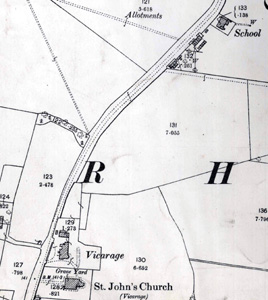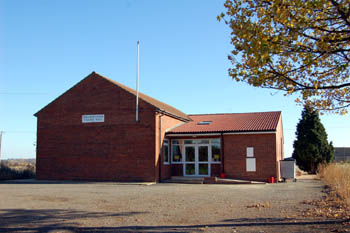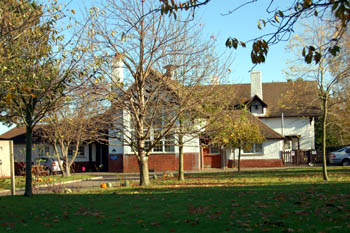Mogerhanger School

The site of Mogerhanger School in 1901
Before 1870
In 1818 a Select Committee was established to enquire into educational provision for the poor. This was no doubt prompted in part by the recent foundation of two societies promoting education and specifically the building of schools. The Society for Promoting the Lancasterian System for the Education of the Poor was established in 1808, promoting schools run along the lines pioneered by Joseph Lancaster, who had himself copied those of Dr. Andrew Bell, in which older children taught their younger fellows. The Society was renamed the British and Foreign School Society in 1814. It was supported by a number of prominent nonconformists; Lancaster himself was a Quaker, and sought to teach a non-sectarian curriculum. In answer to this perceived nonconformist takeover of local education the National Society was formed in 1811 to encourage the teaching of poor children along Anglican lines, including the catechism.
The Select Committee sent a questionnaire to all parishes in the country asking for particulars relating to endowments for the education of children, other educational institutions, observations of parish needs, etc. R. P. Beachcroft, the Rector of Blunham (containing the hamlet of Mogerhanger), reported that there were no endowments for educating the young. There was, though, "a weekly school with 70 boys, and a Sunday school for 80 girls and 70 boys, educated on the national system", both schools supported by the parish inhabitants’ annual subscriptions. The schools were in Blunham but no doubt at least some children from Mogerhanger attended. Beachcroft also observed that ‘the scholars are on the increase, and the poor seem anxious to be benefited by education’. In those days a ‘Sunday School’ was just that: a school which met on a Sunday, usually in the church or nonconformist chapel or other similar building, teaching more than the religious topics with which they are associated today.
In the country generally the number of schools built continued to grow over the next fifteen years so that by 1833 the government agreed to supplement the work of the two societies, and local benefactors, by making £20,000 per annum available in grants to help build schools. It also prompted another questionnaire to be sent to each parish in England asking for details of local educational provision. Schooling in the parish of Blunham had taken a leap forward by then; the reply indicated that there was a daily school with 55 males, and two Sunday Schools, with 74 males and 76 females, chiefly supported by the Rector. Many children from Mogerhanger were among the pupils. Mogerhanger itself (still then a large hamlet of Blunham parish) had two Daily Schools for young children, with about 16 each of boys and girls, their parents paying for their instruction, and it was remarked again that many children attended the Schools at Blunham. A report of 1844 by an inspector lists two "Dame Schools in Cottages" in Mogerhanger, "one of the mistresses a very pleasing dame".
The next national enquiry was in 1846/7 when the Church of England made an enquiry as to all its church schools. This was against the background of a new Whig government which championed secular education, and the increasing importance of nonconformists, particularly Wesleyan Methodist and Roman Catholics, in providing schools. Blunham’s report includes the note of an infants’ daily school for ‘the Hamlets’, attended by ten boys and ten girls.

The Village Hall in November 2007 - site of Mogerhanger's first school
1870-1903
The first Education Act (more correctly known as the Elementary Education Act) was passed in 1870. It was a milestone in the provision of education in Britain, demonstrating central government's unequivocal support for education of all classes across the country. It also sought to secularise education by allowing the creation of School Boards. These were groups of representatives elected by the local ratepayers, and the Board had the powers to raise funds to form a local rate to support local education, build and run schools and pay the fees of the poorest children; make local school attendance compulsory between the ages of 5 and 13; and could even support local church schools, though in practice they replaced them, turning them into Board-run schools (known as Board Schools). Naturally, and luckily for local historians, the Act required a questionnaire of local schools in 1870.
The subsequent printed notice of return for Mogerhanger shows that a National School had been established in the new (since 1866) parish. The Victoria County History gives the date of the school as 1861 and the gift of Mrs. Elizabeth Dawkins of Mogerhanger House, widow of the Rev. Edward Henry Dawkins, who also built the church in memory of her husband. Kelly's Directory of 1877 notes that the school had formerly been a nonconformist chapel.The 1870 report states: "No efficient school. Accommodation for 87 children in Mogerhanger. If the Mogerhanger National School be at once made efficient by building offices [sanitary accommodation] and providing desks, and if it can be enlarged by adding a classroom so as to accommodate in all 87 children, no further accommodation will be required". The site of the old school is that of the Village Hall today, on the north side of the village on the road to Chalton.
In the event the school managers made no plans for improvements and, in a General Report of 1880 her Majesty's Inspector for Bedfordshire and Huntingdonshire attacked nine schools districts, including Mogerhanger, for their apathy and "unwillingness to saddle themselves with what they believe to be the expense and trouble of a connexion with Government". They had: "rendered the Education Acts virtually inoperative within their parishes". One way to force change would have been to create a School Board to remedy matters but this never happened in Mogerhanger.

Moggerhanger School November 2007
1903-1944
A landmark Education Act was passed in 1902, coming into effect in 1903. It disbanded the School Boards and gave responsibility for the day-to-day running of education to newly formed Local Education Authorities, usually the county council, as in Bedfordshire. The old Board Schools became Council Schools whilst the old National, British and other non-Board schools became known as Public Elementary Schools. Mogerhanger, therefore, became a Public Elementary School.
In 1909 Mogerhanger was grouped with the Sandy Council School and the Group was managed jointly by the existing managers plus two more, one appointed by the County Council and one by the Mogerhanger Parish Council. A new school building for Mogerhanger was proposed in 1909 and opened in March 1911. The School Managers’ Minutes for the February 1911 meeting show that they intended the new school to be open parents and friends on 10th March to view; at the time of the meeting it still needed warming and airing and had little furniture, but was all but ready to open. They planned to open the school for use on 13th March. It seems likely that it was around this date that Mogerhanger ceased to be a public elementary school and became a council school.
Bedfordshire & Luton Archives & Records Service has a scrapbook of cuttings of visits made to most Bedfordshire Schools by School Inspectors for a period from just before the First World War through the inter-war years [E/IN1/1]. Mogerhanger’s first report is dated 1908: "Miss Cartwright deserves much credit for the good tone and satisfactory level of efficiency maintained in this school. The premises are in many ways very unsatisfactory, and I am glad to hear that a new building is to be provided". The next visit came in 1911: "This year's work has been greatly interrupted by a change of premises and several changes in the Staff. Under these circumstances the present condition of the school is creditable. The older children are well taught. Order might, perhaps, be a little firmer, but the tone is good and the children make satisfactory progress. The infants have suffered more than the senior scholars from changes in teachers. They appear to have been well taught during the greater part of the year but the present Teacher should cultivate a quieter manner and try to improve her methods".
This latter state of affairs was resolved by the time of the next visit, not long after the outbreak of World War One: "The Infants' Class is now in charge of a capable teacher and there is little doubt, as a result of this, that the work of the older scholars will in time show marked progress". As for the school as a whole: "This is a well conducted School; the children take evident interest in their work and on the whole their attainments are creditable". The next inspection was not recorded until 1921, when average attendance was 62, and the merry-go-round of teachers was even worse than before the war: "Considering that during the past 12 months the school has been under the charge of six different teachers, the general condition may be considered as satisfactory". By the time of the next inspection two years later, the teachers were settled, though one had been removed due to numbers, but the school had been disrupted by a long closure due to epidemics (probably mumps, measles or similar diseases). "But after all these adverse circumstances have been taken into consideration", the report states, "it is felt that the condition of the school is not quite satisfactory"; all the written work was regarded as poor, arithmetic was particularly weak and the Bedfordshire accent was too pronounced, pronunciation being ‘harsh and incorrect’. One bright spot was the youngest children: "The Infants' Class has, again, made a really good beginning. The Assistant Teacher deserves much credit for her work here".
Due to the poor nature of the report the school was visited again the next year when "The work of the older scholars has improved since the last Report was made; further improvement is to be desired". As for the infants: "This class is, as usual, very skilfully taught, and in every respect reflects great credit on the teacher". The inspection of 1927 concentrated on the school garden: "This subject is taught by a local gardener who was not present when the school was visited. The plots are well managed and good vegetable crops are grown. Some flowers and apples are also cultivated; but no fruit trees or bushes are propagated. Scholars were unable to explain much about the garden crops and processes, and though as gardening the work is quite satisfactory its educational value seems to be rather low".
In 1927 the report noted much improvement overall: "This little school is conducted with ability and much vigour. The Head Mistress sets before herself a high standard for the children in discipline, in work, and in the full use of time; and the strict training given in these directions shows in the appearance of the children, their good behaviour, and the good level of their attainments. It is a question, however, whether with such small numbers in the three classes the rigidity necessary in dealing with large numbers might not be relaxed with advantage. The Infants particularly would benefit from more freedom of movement in their classroom". The final report in the scrapbook is dated 1935, when average attendance was down to 46 as a result of losing children aged 11 and over to senior schools elsewhere when the school was reorganised as a Junior School: ‘This Junior School is doing sound, honest work, with a good grounding in the Infants' room well followed up…the response and keenness displayed in all subjects reflects much credit upon the Teachers".
1944 to date
The third of the great Education Acts was that of 1944 which established the principle of County Primary Schools for children up to the age of 11, at which time they took an examination to determine the nature of the secondary school they would attend until they were 15, the most academically able going to grammar schools, the rest to secondary or secondary modern schools.
In the 1970s Bedfordshire County Council introduced comprehensive education, doing away with the 11+ examination and grammar schools and introducing a tier of school between the old CountyPrimary and CountySecondary Schools. Thus, Lower Schools now taught children aged 4 to 9, Middle Schools from 9 to 13 and Upper Schools from 13 onwards. Mogerhanger’s primary school changed its title once again and became a Lower School. After the 1988 Education Act, Mogerhanger decided to be a Grant Maintained school and opted out of local authority control; the ‘grant maintained’ scheme was repealed by central government in 1998 and the school became a Foundation School, still called Moggerhanger Lower School and state funded, via the LEA, but with the governing body having more freedom to run the school than is the case with LEA controlled schools.